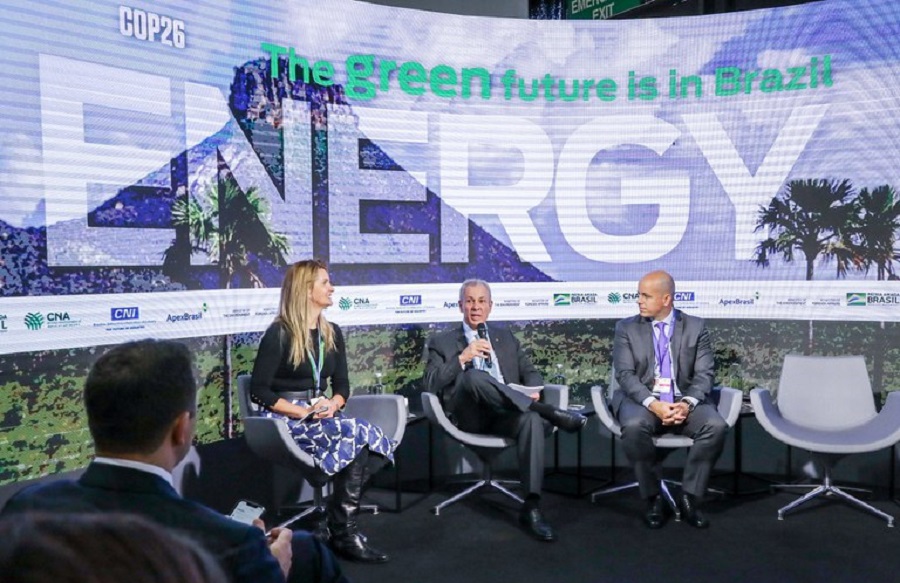RIO DE JANEIRO, BRAZIL – The federal government, through the Ministry of Environment, on Wednesday, November 3, took part in the opening of the first clean energy panel in the Brazilian agenda for COP26.
During the debate, in Glasgow, Scotland, it announced that Brazil will have 50% of its energy matrix clean by 2030. The goal was previously 48%.

“We have a range of international agendas, in which Brazil has been very actively present, highlighting its commitment to the energy transition to a low carbon future. The Brazilian energy sector is very well positioned in this process,” Albuquerque said.
The Minister pointed out that there is no single technological solution in the world to bring about this change in the sector and that each country must seek the best way to reduce carbon emissions into the atmosphere. “Each country must consider its natural resources, its competitive advantages, so that it can achieve its decarbonization goals.”
Albuquerque cited the RenovaBio and Fuel of the Future programs as examples of measures for Brazil’s energy transition. “We have now reduced over 700 million carbon gas emissions. We will also take giant steps in terms of regulatory and market designs,” he said.
The main raw material, sugar cane accounts for 19% of Brazil’s energy matrix through the share of ethanol, bagasse, bioelectricity, and biogas, the Minister said. “Biofuels, in particular ethanol and biogas, whose main source is also sugar cane, have played and will play an increasingly significant role in efforts to decarbonize the transport sector,” he added.
SCIENCE AND ENVIRONMENT
In another panel, at the Brazil pavilion in Brasilia (Federal District), Minister of Environment Joaquim Leite received Minister of Science, Technology and Innovations Marcos Pontes to discuss the positive impact of science on the initiatives of the National Green Growth Program.
“Within the Green Growth program, we have nanotechnology and biotechnology, which are great solutions to better use natural resources and to better understand biomes,” Leite said. “Nothing better than science to provide greater efficiency in the use of natural resources and the generation of green jobs,” he added.
Minister Marcos Pontes pointed out that Brazil ranks 13th in the world in scientific research production and that the challenge is to convert knowledge into new products and services. In the energy area, which affects the environment, science is working on improving the production of photoelectric cells with niobium-based batteries, wind energy and hydrogen from clean sources.
“We have hundreds of projects and startups connected to help protect the environment and develop artificial intelligence systems and the internet of things,” he said.
Pontes also highlighted the installation of 50 laboratories in the Amazon region to study the biodiversity of the planet’s largest tropical forest. The study will seek deeper knowledge about medicines made from Amazonian resources, for instance.
SUCCESSFUL CASES
The day also featured lectures from companies in the energy sector operating in Brazil. Raízen, one of the invited speakers, cultivates 1.3 million hectares of sugar cane in Brazil and operates 31 bioenergy farms. Its second generation ethanol project was presented in the panel.
“Historically, sugarcane sap has been highly exploited [for ethanol production]. We are now exploring the energy derived from the bagasse and other parts, such as leaves and stalks [what we call second generation ethanol],” explained the company’s vice-president Paulo Neves. By using other elements of sugarcane, fuel production can be increased by 50% “with the same area, the same plant, and the same team,” he said.
Brazilian Sugarcane Industry Association (UNICA) chairman Evandro Gussi said that the organization comprises 360 mills in the country, accounting for 70% of the sugarcane produced in Brazil. The raw material is used in the production of bioelectricity. “This means 12 million homes, per year, supplied with clean, sustainable energy. It is a great example of a circular economy,” he pointed out.
According to BSBIOS CEO Erasmo Battistella, the company produced close to 5 billion liters of biodiesel in the past decade and prevented the emission of 9.2 million tons of carbon dioxide, equivalent to 41 million trees. “It is a clear example of how the biodiesel industry has helped address climate change by producing quality biofuel,” he stressed.
ABIOGÁS CEO Alessandro Gardemann said that the company has 600 plants operating in Brazil. “The market has been steadily growing in Brazil, 30% a year, over the past 10 years,” he said. However, the figure is still low. “We account for less than 0.01% of the Brazilian energy matrix.”
“We use less than 2% of the biogas potential”, he lamented. On the other hand, Gardemann said that the outlook is “encouraging.” “We want to transform this opportunity, mainly in agro-industry and sanitation, into a gas production plant,” he added.

